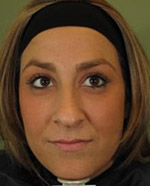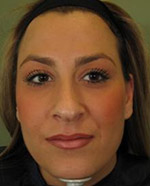Skin Cancer
Skin cancer occurs when skin cells start growing abnormally, causing cancerous growths.
Most skin cancers develop on the visible outer layer of the skin (the epidermis), particularly in sun-exposed areas (face, head, hands, arms, and legs). They are usually easy to detect by examining the skin, which increases the chances of early treatment and survival.
What are the different types of skin cancer?
There are different types of skin cancer, each named for the type of skin cell from which they originate. The majority of skin cancers fall into one of the following categories:
- Basal cell carcinoma (also called BCC) comes from the basal cells in lowest part of the epidermis. 80-85% of skin cancers are basal cell carcinomas.
- Squamous cell carcinoma (also called SCC) comes from the skin cells (keratinocytes) that make up the top layers of the skin. About 10% of skin cancers are SCC.
- Melanoma comes from skin cells called melanocytes, which create pigment called melanin that gives skin its color. 5% of all skin cancers are melanoma. Although less common, melanomas are a very dangerous type of skin cancer and are the leading cause of death from skin disease.
Basal cell and squamous cell carcinoma are sometimes referred to as “non-melanoma skin cancer” to distinguish them from melanoma.
There are a variety of less common types of skin cancers, including cutaneous T-cell lymphoma (CTCL) and Merkel cell carcinoma.
Skin cancer is considered low risk when the affected cells remain clustered in a single group. It is considered high risk when the cells have invaded surrounding tissues. High risk forms of cancer require more aggressive treatments.
Almost all skin cancers start as a small, low-risk lesions, but can grow and become high-risk lesions if left untreated. Melanoma is the most alarming type because it has a higher risk of invading surrounding tissues or spreading to other parts of the body (metastasis) before being detected. Squamous cell and basal cell skin cancer are more likely to be detected and treated effectively before they become malignant.
If skin cancer is detected before it has spread to surrounding tissues, chances of a complete cure are excellent.
Precancerous skin lesions (precancers)
Skin cancer may often be preceded by lesions called pre-cancers. The most well-known of these lesions is called actinic keratosis (AKs).
An actinic keratosis is considered an early form of squamous cell carcinoma. An actinic keratosis, a new or changing mole (nevi), and other unusual lesions on your skin should be carefully monitored and brought to the attention of your doctor.
How is skin cancer treated?
Diagnosing cancer usually requires a skin biopsy. A small piece of skin is removed for examination under a microscope and evaluated with other tests.
The recommended treatment plan is based on several factors:
- The type of cancer (basal cell, squamous cell, melanoma, or other)
- The size of the cancer—treatments that may be effective for small cancers may not be optimal for larger cancers
- The extent of the cancer (localized to one area vs. spreading to surrounding tissues)
- The location of the cancer (face vs. arm)
- The number of lesions
- Your past history and family history of skin cancers
In general, the treatment plan is based on the risk of the cancer spreading to another location or growing again (recurring) in the same location. Cancers that are likely to spread or recur are treated more aggressively.
Skin Cancer Medications
There are several topical medications that may be prescribed for the treatment of different types of skin cancer, or precancerous lesions, such as AKs.
- 5-fluorouracil (Efudex, Carac)
- Imiquimod 5% (Aldara), and 3.75% (Zyclara)
Skin Cancer Procedures
Several dermatological procedures may be performed to remove skin cancers.
Radiation and chemotherapy may be recommended in cases when the cancer has spread, or when other medical conditions prevent the use of other treatments.
What causes skin cancer?
Sunlight is composed of visible light (all the colors we see in daylight), infrared radiation (which provides warmth), and ultraviolet (UV) radiation, which is carcinogenic (cancer-causing). More than 90 percent of all skin cancer is caused by long-term exposure to UV radiation.
UV radiation damages the skin’s DNA, causing a cell to behave abnormally. The body normally has mechanisms to repair damaged DNA but these repair mechanisms do not function normally after exposure to UV radiation. This allows the abnormal skin cell to replicate itself, making more cells with the same damaged DNA. This growing collection of abnormal cells is the beginning of a cancer.
The immune system can often detect and destroy cancer cells, just as it defends against infections by bacteria or viruses. However, UV radiation disrupts the immune system so that our natural defenses may not detect the cancer, allowing it to grow unchecked.
Melanin in the skin, which gives skin its tan to brown color, can block the damaging effects of UV radiation. The more melanin, the darker the skin. And the darker the skin, the better protected it is from UV radiation. This is why a body darkens when exposed to sunlight (tanning). It is trying to build a better shield.
However, the melanin provides only partial protection, even for those with very dark skin. And those with fair skin have almost no melanin to protect them.
It is important to remember that a tan develops only after the skin has been damaged by UV radiation, and that this tan provides only minor protection from additional damage.
In addition to sun exposure, family history may also play a role in a small percentage of skin cancers, especially melanomas.
How can I prevent skin cancer?
The best protection against skin cancer is to minimize sun exposure, especially between 10 a.m. and 4 p.m. If you do go out in the sun, practice good sun protection habits: use a broad-spectrum sunscreen (SPF 30 or higher that protects against UVA and UVB), making sure to cover the head, lips, hands, neck, and ears. Wear a wide-brimmed hat, sunglasses, and protective clothing. Not only will this dramatically decrease your risk of skin cancer, but it will prevent other sun-damaging conditions, like wrinkles and actinic keratoses.
Indoor tanning booths increase the risk of developing skin cancer, despite any claims of their being a safe alternative to natural sunlight. The skin doesn’t tan unless it is first damaged by UV radiation. Intentional tanning should be avoided like any health hazard, such as smoking.
While everyone should minimize their exposure to the sun and UV radiation, fair-skinned people, outdoor workers, and residents of sunny climates should use particular caution.
Another effective weapon against skin cancer is regular skin self-exams. Use a Body Mole Map to record where spots appear on your skin. You can refer to this record the next time you perform a skin exam to determine if there have been any changes.
Because skin cancer can resemble other skin conditions, be sure to tell your doctor about unusual skin changes or lesions, especially these:
- A sore that comes and goes but never completely heals
- A shiny bump or nodule, especially if it appears pearly or translucent (these can look brown or reddish and resemble a mole)
- A slightly raised pink growth with a crusted depression in the center, possibly with tiny blood vessels (capillaries) visible on the surface
- A patch of skin that is red or irritated, especially on the chest, shoulders, or limbs
- A white or yellow-ish waxy scar with poorly defined borders
If you have any risk factors, such as prolonged sun exposure, family history, or a past cancerous lesion, you may benefit from having your skin checked regularly by your doctor.
Source: www.fromyourdoctor.com














